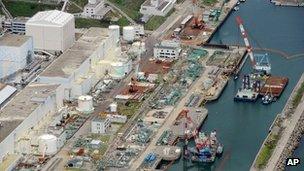Fukushima nuclear plant: Japan takes steps over sea leak
- Published

The crippled Fukushima plant has faced water leaks and power cuts in recent months
Japan says it is taking steps to prevent contaminated water from the crippled Fukushima nuclear plant leaking into the sea.
The plant's operator recently admitted for the first time that radioactive water was still going into the sea.
A government spokesman said the authorities had taken immediate action.
Workers were asked to act promptly to stop the leak as steam was seen rising from one of the reactor buildings for the second time in a week.
On Tuesday, Tokyo Electric Power Company (Tepco) said steam was seen around the fifth floor of the building housing Reactor No 3 shortly after 09:00 local time (00:00 GMT).
Workers were continuing with the ongoing operation to inject cooling water into the reactor and a pool storing nuclear fuel, it added.
It is not clear what is causing the steam, but levels of radiation around the reactor have not changed.
The sight of steam rising is worrying because it means somewhere inside the reactor building water is boiling, says the BBC's Rupert Wingfield-Hayes in Tokyo.
The badly damaged reactors are supposed to be in what is called "cold shutdown"; the temperature of the cooling water inside the reactor should be well below boiling point.
It is another sign that Tepco still does not fully know what is going on inside the damaged reactors, our correspondent adds.
Steam was last seen rising from a reactor building at the plant on 18 July.
The plant was crippled by an earthquake and tsunami in 2011, which knocked out cooling systems to the reactors, three of which melted down.
Leak
On Monday, Tepco said the plant was likely to be leaking contaminated water into the sea, something that has been suspected for some time, but previously denied by the company.
Outside experts have long suspected that the damaged reactors are leaking water, because of the very high levels of radioactive caesium still being found in samples of fish taken near the plant.
"High readings of radiation were detected from the soil [ground] of the turbine building. We are very sorry for causing concerns to many people, and especially we deeply apologise to the people of Fukushima," a company spokesman said.
Plant officials believe a leak is possible because the underground water levels in suspected areas fluctuate according to tide movements and rainfall, he added.
The Japanese government says it is taking the issue seriously.
"The ministry of trade, economy and industry was instructed to act promptly to prevent contaminated water from leaking to the ocean," Chief Cabinet Secretary Yoshihide Suga told a news conference on Tuesday.
Since 2011, the plant has seen a series of water leaks and power failures.
Earlier this month, a sharp increase in radioactive caesium was detected in groundwater 25 metres (82ft) from the sea.
In June, radioactive water was also found to be leaking from a storage tank.
Experts say years of work lie ahead before the problems at the plant can be fully contained.
- Published18 July 2013
- Published10 July 2013
- Published6 June 2013
- Published22 April 2013
- Published9 April 2013
- Published11 March 2013